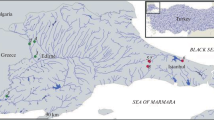Abstract.
As a top-level predator, the brown grouper Epinephelus marginatus can play an important role in maintaining the ecological balance of hard-bottom ecosystems. However, to fulfil this role, the species must have a sufficient population density and a wide size range. The presence of such a "healthy" grouper population is one of the known benefits of the protection measures applied to marine protected areas. The availability, in marine reserves, of areas suitable for settlement and recruitment of early juveniles can contribute to preserving a well-structured population. Thus, knowledge of microhabitats preferred by juvenile groupers is an important step in locating, within protected or not yet protected areas, nursery sites that might need a specific protection regime. The aim of the present work was to evaluate habitat and microhabitat preferences of juvenile E. marginatus, in comparison with two other serranids of comparable size, Serranus cabrilla and S. scriba, in the marine reserve of Ustica Island (SW Mediterranean). At different sites, located along the shallow coastal area of the reserve, 329 individuals of the three serranid species were visually surveyed by means of skin- or SCUBA-diving in June 1999. The location of each encountered fish was characterised by both biotic and abiotic variables evaluated at two spatial scales. In order to assess interspecific differences in the use of the spatial environment, the results were analysed by correspondence analysis. According to observations on a small spatial scale, juvenile groupers showed a preference for cavities and recesses, in clear contrast with both Serranus species. When out of such sheltered places, juvenile groupers avoided visually exposed locations (convex substrates and very large visual fields), preferring flat or sub-horizontal rocky substrates. Conversely, S. scriba, and especially S. cabrilla, chose rather open microhabitats (flat to convex substrates, with large to very large visual fields). On a larger spatial scale, brown groupers and the two other serranids showed no marked differences in their habitat preferences.
Similar content being viewed by others
Author information
Authors and Affiliations
Additional information
Electronic Publication
Rights and permissions
About this article
Cite this article
La Mesa, .G., Louisy, .P. & Vacchi, .M. Assessment of microhabitat preferences in juvenile dusky grouper (Epinephelus marginatus) by visual sampling. Marine Biology 140, 175–185 (2002). https://doi.org/10.1007/s002270100682
Received:
Accepted:
Issue Date:
DOI: https://doi.org/10.1007/s002270100682




